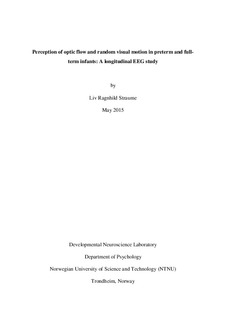| dc.description.abstract | Electroencephalogram (EEG) was used in preterm and full-term infants at 5 and 12 months of age to longitudinally study brain electrical activity as a function of perception of structured forward optic flow, structured reversed optic flow, and non-structured random visual motion. This study aimed to investigate how developments in neuronal maturation and locomotion are related to changes in brain activity. Analyses of visual evoked potentials (VEPs) and temporal spectral evolution (TSE, time-dependent amplitude changes) were performed on EEG data recorded with a 128-channel Geodesic Sensor Net 200 (GSN). In full-term infants, VEP results revealed a significant decrease in latencies for forward and reversed optic flow, but not for random visual motion with age. At 12 months, full-term infants were also found to significantly differentiate between the three motion conditions, with shortest latencies for forward optic flow, and longest latencies for random visual motion. When the TSEs of the three motion conditions were compared to the TSEs of a static non-flow control condition, full-term infants at 5 and 12 months showed significant differences in induced activity. A decrease in amplitudes at 4.6-7.9 Hz was observed as desynchronized theta-band activity at both ages in full-term infants, while an increase in amplitudes at 13-21 Hz was observed as synchronized beta-band activity only at 12 months. Preterm infants showed a different developmental trend to full-term infants, as the VEP results revealed that they did not decrease their latencies with age, nor were able to significantly differentiate between the motion conditions at 12 months. When the TSEs of the motion conditions were compared to the TSEs of the static non-flow condition, preterm infants at 5 and 12 months showed significant differences in induced activity. A decrease in amplitudes at 4.9-7.2 Hz was observed as desynchronized theta-band activity at both ages in preterm infants. Although some preterm infants showed an increase in amplitudes at 13-21 Hz that was observed as synchronized beta-band activity, it was not as prevalent as that observed in their full-term peers. It was concluded that the preterm infants’ atypical responses could be related to brain anomalies related to dorsal stream vulnerability, while full-term infants’ progression in visual motion perception could reflect increased neuronal maturation and locomotion experience. More follow-up research is required to investigate the long-term effects of dorsal stream impairment. | nb_NO |
